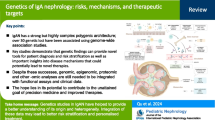Abstract
Familial renal glucosuria (FRG) is characterized by persistent glucosuria despite normal serum glucose and in the absence of overt tubular dysfunction. Mutation of sodium/glucose co-transporter 2 (SGLT2) has been identified and was recently reported to be involved in FRG. However, the functional and pathological consequences of such mutations remain unknown. In the current study, we collected four families with FRG. Sequencing of the SGLT2 coding region, intronic segments and cDNA revealed three missense mutations (294C>A: F98L; 1388T>G: L463R; 1435C>G: R479G) and two splice mutations (IVS 1-16 C>A: Del exon3; IVS 11 + 1 G>C: Del exon11). The probands were either heterozygous or compound heterozygous for SGLT2 mutations, and had glucosuria quantified at 6–27 g/day. Human 293 cells were transfected with the plasmid constructs to study the expression and function of SGLT2 mutants in vitro. Confocal microscopy using green fluorescent protein (GFP) revealed that the mutation results in a loss of punctate membrane pattern typical of the wild-type SGLT2 except in the 294C>A mutant. All mutants had significantly lower transport capacity in comparison to the wild-type control (26.49–71.48%). Renal biopsy in one consenting proband revealed significantly lower SGLT2 expression in the apical side of the proximal convoluted tubule in comparison to both healthy and disease controls (minimal change disease and diabetic nephropathy). The current study provides functional clues regarding the SGLT2 molecule from genotype to phenotype in FRG families.







Similar content being viewed by others
References
Calado J, Soto K, Clemente C, Correia P, Rueff J (2004) Novel compound heterozygous mutations in SLC5A2 are responsible for autosomal recessive renal glucosuria. Hum Genet 114:314–316
Calado J, Loeffler J, Sakallioglu O, Gok F, Lhotta K, Barata J, Rueff J (2006) Familial renal glucosuria: SLC5A2 mutation analysis and evidence of salt-wasting. Kidney Int 69:852–855
Calado J, Sznajer Y, Metzger D, Rita A, Hogan MC, Kattamis A, Scharf M, Tasic V, Greil J, Brinkert F, Kemper MJ, Santer R (2008) Twenty-one additional cases of familial renal glucosuria: absence of genetic heterogeneity, high prevalence of private mutations and further evidence of volume depletion. Nephrol Dial Transplant 23:3874–3879
Chazotte B (2008) Labeling the components of the plasma membrane with fluorescent dyes for imaging. Cold Spring Harb Protoc. doi:10.1101/pdb.prot4930
Francis J, Zhang J, Farhi A, Carey H, Geller DS (2004) A novel SGLT2 mutation in a patient with autosomal recessive renal glucosuria. Nephrol Dial Transpl 19:2893–2895
Kanai Y, Lee WS, You G, Brown D, Hediger MA (1994) The human kidney low affinity Na(+)/glucose cotransporter SGLT2: delineation of the major renal reabsorptive mechanism for d-glucose. J Clin Invest 93:397–404
Kleta R, Stuart C, Gill FA, Gahl WA (2004) Renal glucosuria due to SGLT2 mutations. Mol Genet Metab 82:56–58
Liu X, Sun Y, Constantinescu SN, Karam E, Weinberg RA, Lodish HF (1997) Transforming growth factor beta-induced phosphorylation of Smad3 is required for growth inhibition and transcriptional induction in epithelial cells. Proc Natl Acad Sci USA 94:10669–10674
Magen D, Sprecher E, Zelikovic I, Skorecki K (2005) A novel missense mutation in SLC5A2 encoding SGLT2 underlies autosomal-recessive renal glucosuria and aminoaciduria. Kidney Int 67:34–41
Miller SA, Dykes DD, Polesky HF (1988) A simple salting out procedure for extracting DNA from human nucleated cells. Nucleic Acids Res 16:1215
Neitzei H (1986) A routine method for the establishment of permanent growing lymphoblastoid cell lines. Hum Genet 73:320–326
Pajor AM, Randolph KM, Kerner SA, Smith CD (2008) Inhibitor binding in the human renal low- and high-affinity Na+/glucose cotransporters. J Pharmacol Exp Ther 324:985–991
Santer R, Kinner M, Lassen CL, Schneppenheim R, Eggert P, Bald M, Brodehl J, Daschner M, Ehrich JH, Kemper M, Li Volti S, Neuhaus T, Skovby F, Swift PG, Schaub J, Klaerke D (2003) Analysis of the SGLT2 gene in patients with renal glucosuria. J Am Soc Nephrol 14:2873–2882
Scholl-Burgi S, Santer R, Ehrich JH (2004) Long-term outcome of renal glucosuria type 0: the original patient and his natural history. Nephrol Dial Transpl 19:2394–2396
Uldry M, Thorens B (2004) The SLC2 family of facilitated hexose and polyol transporters. Pflugers Arch Eur J Physiol 447:480–489
Vallon V, Platt KA, Cunard R, Schroth J, Whaley J, Thomson SC, Koepsell H, Rieg T (2010) SGLT2 mediates glucose reabsorption in the early proximal tubule. J Am Soc Nephrol [Epub ahead of print]
Van den Heuvel LP, Assink K, Willemsen M, Monnens L (2002) Autosomal recessive renal glucosuria attributable to a mutation in the sodium glucose cotransporter (SGLT2). Hum Genet 111:544–547
Wells RG, Mohandas TK, Hediger MA (1993) Localization of the Na+/glucose cotransporter gene SGLT2 to human chromosome 16 close to the centromere. Genomics 17:787–789
Wright EM, Turk E (2004) The sodium/glucose cotransport family SLC5. Pflugers Arch 447:510–518
Wright EM, Hirayama BA, Loo DF (2007) Active sugar transport in health and disease. J Intern Med 261:44–52
Acknowledgments
We thank the FRG patient and healthy controls who participated in this study. This work was funded by the National Natural Science Foundation of China (#30825021 and 30971371), Specialized Research Fund for the Doctoral Program of Higher Education of China (#200800010086), and the Foundation of Ministry of Health of China (#200802052).
Conflict of interest
All the authors declared no competing interests.
Author information
Authors and Affiliations
Corresponding author
Rights and permissions
About this article
Cite this article
Yu, L., Lv, JC., Zhou, Xj. et al. Abnormal expression and dysfunction of novel SGLT2 mutations identified in familial renal glucosuria patients. Hum Genet 129, 335–344 (2011). https://doi.org/10.1007/s00439-010-0927-z
Received:
Accepted:
Published:
Issue Date:
DOI: https://doi.org/10.1007/s00439-010-0927-z




